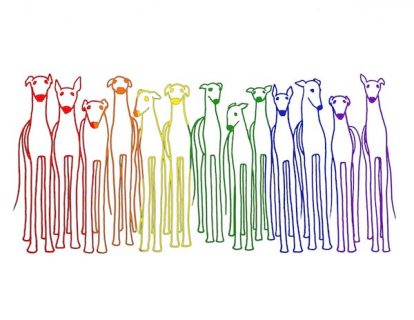
In a post written not long ago, we talked about gray colored Greyhounds, about how they are fairly rare, and that such dogs aren’t referred to as gray Greyhounds, but as “blues.” We subsequently heard from a few readers who suggested that the rarity of the color might be geo-specific. In other words, the color wasn’t rare where they lived (Europe), but was in the United States where it’s scarcely seen.
Interesting, and good to know.
Having said that, we came across another color in the breed regarded as uncommon. Indeed, our understanding is that this color is so rare that it appears approximately one in every 1,500 to 2,000 litters: The color is known as “Dun,” or “liver” (depending upon where you live).
Dun can appear as a light blue fawn, a rich red fawn, and up to a deep chocolate color, but the dominating factor is pink to brown colored nose leather and brown toenails on every paw. It’s worth noting that dun isn’t so much a color as a gene that turns black hair into brown, not unlike the dilution gene that gives us a “blue” dog. Some Dun colored hounds have been recorded in the past as being red fawn, dark fawn, or red, but as they are a color apart, this wouldn’t be entirely accurate.
It’s said that genetically speaking, all present day dun-colored Greyhounds have a double cross of a Greyhound named, “Rocket Jet,” a dog born in 1950 who was a multiple track record breaker and held five track records at one time. He was described as a sensational brood sire, perhaps Australia’s best stud dog of his era, his get having won multiple track cups, themselves. He could also be regarded as prepotent in that he passed the dun gene on to offspring, and rare as the color is, it’s still showing up seventy years later.
It’s said that a good Greyhound doesn’t have a bad color, and this is probably because dogs were always selected for speed instead of color. Add to this that in this breed, modifiers are so numerous or so variable that the breed has a plethora of colors in its gene pool. Whelping Greyhound pups has to be exciting for a breeder because every puppy can be a different color with the exception of merle, and black and tan. That said, one supposes that it can also be frustrating to discuss colors because some people use terms that describe the dog’s appearance, and not terms that discuss the dog’s genetic coloring.
We didn’t have consent to share any images of dun colored Greyhounds, but you can see one here.
Image: “Rainbow Greyhounds” by Meg Dwyer Skiba, owner of StoneAvenueStudio is available in print form here.
